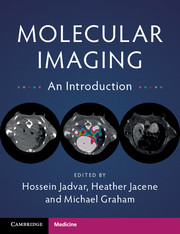Book contents
- Frontmatter
- Contents
- List of Contributors
- Preface
- 1 Instrumentation – CT
- 2 MRI/ MRS Instrumentation and Physics
- 3 Optical and Ultrasound Imaging
- 4 Instrumentation-Nuclear Medicine and PET
- 5 Quantitation-Nuclear Medicine
- 6 Perfusion
- 7 Metabolism
- 8 Cellular Proliferation
- 9 Hypoxia
- 10 Receptor Imaging
- 11 Apoptosis
- 12 Angiogenesis
- 13 Reporter Genes
- 14 Stem Cell Tracking
- 15 Amyloid Imaging
- Index
- References
9 - Hypoxia
Published online by Cambridge University Press: 22 November 2017
- Frontmatter
- Contents
- List of Contributors
- Preface
- 1 Instrumentation – CT
- 2 MRI/ MRS Instrumentation and Physics
- 3 Optical and Ultrasound Imaging
- 4 Instrumentation-Nuclear Medicine and PET
- 5 Quantitation-Nuclear Medicine
- 6 Perfusion
- 7 Metabolism
- 8 Cellular Proliferation
- 9 Hypoxia
- 10 Receptor Imaging
- 11 Apoptosis
- 12 Angiogenesis
- 13 Reporter Genes
- 14 Stem Cell Tracking
- 15 Amyloid Imaging
- Index
- References
Summary
Hypoxia is a significant modifier of malignant tumors, generally increasing their resistance to therapy. It has been known for decades that hypoxic tissue is less radiosensitive than normoxic tissue. The ratio of radiation sensitivities between normoxic and hypoxic tissue, also called the oxygen enhancement ratio (OER), can be as high as 3.0. Radiation oncologists recognize this problem and have adapted their treatment methodology, that is fractionation schedules, to take it into account.
However, hypoxia has multiple other effects beyond increasing the radio-resistance of tumors. In the presence of hypoxia, a number of intracellular pathways are activated, leading to increased levels of HIF-1a, which, in turn, activates a large number of genes, leading to increased levels of enzymes that increase glucose metabolism, apoptosis resistance, angiogenesis, and promote invasion and metastases in tumors. In addition, hypoxia is almost always associated with very low blood flow and results in poor delivery of intravenous chemotherapy drugs to the tumor.
Direct Measurement of Tissue Oxygen
The polarographic oxygen electrode methodology is generally accepted as the gold standard for measuring tissue oxygen levels. A commercially available system is manufactured by Eppendorf. The electrodes consist of a gold cathode with an insulating glass sheath. The cathode tip is recessed and covered by an oxygen permeable membrane, such as Teflon. The anode is silver-silver chloride. The electrode is in the form of a needle, which is slowly advanced into the tissue automatically. Significant problems with this approach are that it is invasive and can be difficult to implement.
Another, more recent oxygen probe is an optical fiber device that has a ruthenium lumiphor incorporated into a silicone polymer at the tip of the probe. Light pulses through the optical fiber induce fluorescence of the lumiphor, which can be detected. The lifetime of the fluorescent pulses is inversely related to the oxygen level at the tip.
Magnetic Resonance Spectroscopy (MRS)
An important subset of genes up-regulated by HIF-1a are the genes coding for glycolytic enzymes, such as lactate dehydrogenase and pyruvate dehydrogenase kinase. Their increased activity increases tumor glycolysis, along with increased production of lactate. The concentration of lactate can be estimated, using proton MRS, and this has been used to identify areas of hypoxia within tumors. The methodology is not simple and is difficult to quantitate; however, it is useful qualitatively.
- Type
- Chapter
- Information
- Molecular ImagingAn Introduction, pp. 39 - 42Publisher: Cambridge University PressPrint publication year: 2017



